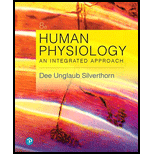
Concept explainers
(a)
To determine: The definition and physiological significance of lipoprotein lipase.
Introduction: Proteins are important macromolecules that are involved in most of the metabolic activities. They are composed of amino acids. The amino acids join together with the help of polypeptide bonds to form proteins.
(b)
To determine: The definition and physiological significance of amylin.
Introduction: Islet cells are the cluster of cells that release insulin in the body. They are found in the pancreas. Islet cells are involved in the formation of amylin.
(c)
To determine: The definition and physiological significance of ghrelin.
Introduction: Food is a vital requirement for the survival of organisms. Every organism requires energy and energy is obtained by the food. There are many types of neurotransmitters that help in food intake.
(d)
To determine: The definition and physiological significance of neuropeptide Y.
Introduction: Neurotransmitters are the chemicals that are released by the neurons. They help in generating responses against the stimulus. The neurotransmitters have been divided into four major chemical classes according to the chemicals that they contain.
(e)
To determine: The definition and physiological significance of apoprotein.
Introduction: The lipoprotein and lipid complexes present in the epithelial cells of intestines are called chylomicrons. The apoprotein is a part of chylomicrons.
(f)
To determine: The definition and physiological significance of leptin.
Introduction: The scientists have proposed a theory called the lipostatic theory. According to it, the signals are passed from the adipocytes to the brain. These signals modulate the eating behavior of the organism.
(g)
To determine: The definition and physiological significance of osmotic diuresis.
Introduction: Humans have a well-defined urinary system that helps in the removal of wastes from the blood. The yellowish liquid produced as waste during
(h)
To determine: The definition and physiological significance of insulin resistance.
Introduction: Insulin is a hormone that helps in maintains the blood glucose level in the body. The insulin is produced by a cluster of cells called beta cells. The people suffering from diabetes have a low level of insulin.
Want to see the full answer?
Check out a sample textbook solution
Chapter 22 Solutions
Pearson eText Human Physiology: An Integrated Approach -- Instant Access (Pearson+)
- What is the opening indicated by the pointer? (leaf x.s.) stomate guard cell lenticel intercellular space none of thesearrow_forwardIdentify the indicated tissue? (stem x.s.) parenchyma collenchyma sclerenchyma ○ xylem ○ phloem none of thesearrow_forwardWhere did this structure originate from? (Salix branch root) epidermis cortex endodermis pericycle vascular cylinderarrow_forward
- Identify the indicated tissue. (Tilia stem x.s.) parenchyma collenchyma sclerenchyma xylem phloem none of thesearrow_forwardIdentify the indicated structure. (Cucurbita stem l.s.) pit lenticel stomate tendril none of thesearrow_forwardIdentify the specific cell? (Zebrina leaf peel) vessel element sieve element companion cell tracheid guard cell subsidiary cell none of thesearrow_forward
- What type of cells flank the opening on either side? (leaf x.s.) vessel elements sieve elements companion cells tracheids guard cells none of thesearrow_forwardWhat specific cell is indicated. (Cucurbita stem I.s.) vessel element sieve element O companion cell tracheid guard cell none of thesearrow_forwardWhat specific cell is indicated? (Aristolochia stem x.s.) vessel element sieve element ○ companion cell O O O O O tracheid O guard cell none of thesearrow_forward
- Identify the tissue. parenchyma collenchyma sclerenchyma ○ xylem O phloem O none of thesearrow_forwardPlease answer q3arrow_forwardRespond to the following in a minimum of 175 words: How might CRISPR-Cas 9 be used in research or, eventually, therapeutically in patients? What are some potential ethical issues associated with using this technology? Do the advantages of using this technology outweigh the disadvantages (or vice versa)? Explain your position.arrow_forward
 Biology (MindTap Course List)BiologyISBN:9781337392938Author:Eldra Solomon, Charles Martin, Diana W. Martin, Linda R. BergPublisher:Cengage Learning
Biology (MindTap Course List)BiologyISBN:9781337392938Author:Eldra Solomon, Charles Martin, Diana W. Martin, Linda R. BergPublisher:Cengage Learning BiochemistryBiochemistryISBN:9781305577206Author:Reginald H. Garrett, Charles M. GrishamPublisher:Cengage Learning
BiochemistryBiochemistryISBN:9781305577206Author:Reginald H. Garrett, Charles M. GrishamPublisher:Cengage Learning Human Physiology: From Cells to Systems (MindTap ...BiologyISBN:9781285866932Author:Lauralee SherwoodPublisher:Cengage Learning
Human Physiology: From Cells to Systems (MindTap ...BiologyISBN:9781285866932Author:Lauralee SherwoodPublisher:Cengage Learning





